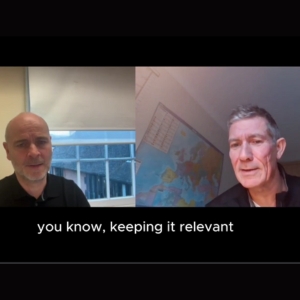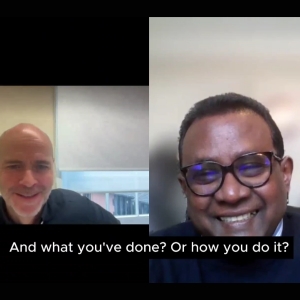Malikshaw Interim
Santa’s Transformation Tangle: Can the Big Man Go Digital?

Picture this: Santa Claus, seated at his desk in the North Pole, staring at a spreadsheet called “Gifting Operations 2024”. His glasses are perched on the end of his nose, a half-drunk mug of cocoa in hand. He’s muttering under his breath:
"Digitise the Naughty-and-Nice list? Upgrade the sleigh? Automate gift wrapping? What’s next—self-driving reindeer?!"
With a groan, he looks at the latest report from Elf Resources: “Elf satisfaction down 12% due to increased workshop deadlines.” Meanwhile, Mrs Claus is gently suggesting he take a webinar on time management. The pressure is real.
Legacy Systems Are a Ho-Ho-Hold-Up
Santa’s sleigh is a legacy system if ever there was one. Sure, it’s magical, but it’s also inefficient: no GPS, zero analytics, and the reindeer union is lobbying hard for better working conditions (Rudolph wants a glow upgrade). But ditching the sleigh for drones feels like sacrilege. Santa knows that digital transformation is key, but will it lose the sparkle that makes Christmas magical?
Bringing the Elves Along for the Ride
Then there are the elves, Santa’s most loyal (if slightly overworked) workforce. Change management isn’t easy when your staff have been handcrafting toys for centuries. Rumours of 3D printers in the workshop have them nervous. One elf was overheard saying, “What’s wrong with chisels? They’ve worked for 500 years!”
Santa knows he needs to upskill his team and reassure them that a little automation doesn’t mean they’ll be out of a job. But how do you explain “agile methodology” to someone whose life revolves around tinsel and wooden trains?
The Boardroom Blitz: Managing Expectations
Of course, Santa’s toughest customers are the kids—the ultimate Board of Directors. They’ve heard whispers of transformation, and the chatter isn’t all positive. One child wrote in asking, “If Santa’s going digital, does that mean I’m getting an NFT instead of a bike?”
Santa knows that no matter the changes behind the scenes, the kids expect flawless delivery—on time, every time. A single missed gift could send his approval ratings plummeting faster than a sleigh with a broken runner.
At Malikshaw, we understand the challenges of transformation—whether you’re streamlining operations in the private sector, meeting new regulatory requirements in the public sector, or trying to modernise the most magical night of the year. We specialise in finding the right leaders to guide projects through complexity, with a touch of charm and plenty of results.
So here’s to Santa—and to all of you tackling your own transformation challenges. Wishing you a season full of joy, innovation, and a little magic.
Happy holidays from Malikshaw Interim & Executive!
Reflections and Resolutions for 2025

As the calendar turns toward the close of one year and the dawn of another, it's a time for reflection and anticipation—a tradition that owes much to Janus, the Roman god of transitions. Janus, who gave his name to January, is famously depicted with two faces: one looking back to the past and the other gazing forward to the future. For centuries, his dual perspective has symbolised wisdom gained from experience and the courage to embrace change.
At Malikshaw Interim & Executive, this dual perspective resonates deeply with the work we do. Over the past year, we’ve stood with clients at the crossroads of change, helping them honour the lessons of the past while preparing to seize opportunities ahead.
Take, for example, our recent collaboration with a major public sector organisation embarking on a digital transformation journey. They faced the daunting challenge of integrating AI technologies into legacy systems while navigating public accountability and ensuring inclusivity in service delivery. It was a classic ‘Janus moment’: recognising the value of established practices but needing to innovate to stay relevant in a rapidly changing environment.
Working alongside their leadership, we assembled an interim team of transformation specialists who didn’t just understand AI—they understood people. By combining technical expertise with empathetic leadership, they helped the organisation demystify AI, implement scalable solutions, and upskill their workforce. Today, they are not only meeting public expectations but setting a benchmark for digital service delivery across their sector.
As we reflect on 2024, we acknowledge that others have achieved far more wide-reaching change than the modest contributions we’ve made. Consider Adrian, who restructured and realigned a failing government transformation program while achieving a 20% budget reduction. Then there’s Kirsty, who introduced a new Project Management Framework that drove down construction costs by millions and simultaneously boosted project productivity.
Jason, through a multi-year transformation programme, turned an initial £5m investment into an £18m annual digital budget and a team of 140 staff. Meanwhile, Carl successfully transformed the aging estate of a government department, and another Jason made the bold decision to cancel $175m in capex investments that had delivered poor ROI.
John oversaw the migration of 13,000 Contact Centre agents across 29 business units, while James led the recovery of a £60m business transformation program for a major international manufacturing organisation.
This demonstrates the breadth and scale of impactful change delivered by these remarkable individuals.
The unifying theme across all these examples is independence. This isn’t about the Big 4 driving change—it’s about the dynamic, highly skilled cohort of Trailblazers that Malikshaw is proud to have brought together. We are dedicating our time and energy to helping organisations of all sizes, sectors, and shapes realise the value of authentic, independent leadership. Independence means examining organisational challenges with clear-eyed objectivity, identifying the most qualified and experienced leader with the highest potential to deliver successful outcomes, and assembling a trusted, highly recommended team around them. This is the core message that resonates from our Transformation Trailblazer cohort.
The best fit. The perfect match. Not, who you are being told is available.
As we look forward to 2025, challenges remain plentiful. Legacy systems must evolve to match the demands of a digitised world. The rise of AI, while thrilling, raises questions about ethics, workforce impact, and long-term societal changes. Meanwhile, geopolitics continues to shape the global economy, influencing supply chains and organisational strategies. Yet within these challenges lie incredible opportunities for those who are prepared to act with foresight and agility.
At Malikshaw, we are committed to partnering with organisations and individuals to navigate these pivotal moments. Whether you’re charting a course for digital transformation, reshaping your workforce for a more dynamic future, or recalibrating your strategy in light of global trends, we’re here to ensure you move forward with clarity and confidence.
As we close out 2024, we’d like to thank you for being part of the Malikshaw network. To all our clients, candidates, and collaborators, we wish you a joyful holiday season and a New Year filled with opportunity, growth, and success. Let’s step into 2025 together—like Janus—with wisdom from the past and excitement for the future.
Malikshaw Interim & Executive
P.S. If you’re facing your own Janus moment, don’t hesitate to reach out—we’d love to explore how we can help you move forward.
Malikshaw in Conversation: Delivering Change
Avoiding the Pitfalls: Navigating the Challenges

Transformation projects are exciting—after all, they hold the potential to change an organisation’s future. But let’s face it, they can also be a logistical nightmare. The reality is that a staggering 70% of transformation projects fail, with many of them going through multiple project leaders before any success is achieved. So why do so many fail? And how can we anticipate those pitfalls before they become insurmountable?
Have you ever found yourself in the middle of a project, unsure if the goal is even achievable? Or worse—have you had to hand over the reins to someone else halfway through?
The challenges in large transformation projects are numerous, but a few key issues consistently cause problems:
- Unclear Goals & Scope: The initial vision is often vague, and over time, the scope creeps, making it harder to stay on track.
- Lack of Stakeholder Buy-In: Without buy-in from key stakeholders—especially at the top—any transformation will struggle.
- Inadequate Leadership: A lack of experienced leadership or frequent changes in leadership can derail progress.
- Resistance to Change: People fear change, and that resistance can slow down or even halt progress.
Now, imagine all these challenges combined in a real-world setting, like a UK Non-Departmental Public Body (NDPB)—a government body tasked with implementing new regulations. The NDPB needs to overhaul its data reporting system to meet new government standards, but the project is running behind schedule, leadership is shifting, and employees are pushing back on the changes.
A Theoretical Case Study: Navigating Transformation in a UK NDPB
This hypothetical NDPB finds itself struggling to balance competing interests: meeting government deadlines, maintaining stakeholder confidence, and ensuring the system overhaul doesn’t disrupt daily operations. Early in the project, the leadership team was not fully aligned on the scope or the approach, leading to delays. Then came a change in leadership, further slowing progress as new leaders had to get up to speed. Finally, there was resistance from employees who were hesitant to adopt the new data processes.
As the project faced these challenges, it became clear that resilience needed to be built into the approach. The solution?
- Clear, Defined Goals: The leadership team redefined the project’s scope, focusing on the most critical aspects first.
- Strong, Consistent Leadership: The project brought in an experienced transformation leader with a proven track record in similar government-based projects.
- Early Engagement: Employees were engaged early in the process, with training and communication aimed at reducing resistance to change.
- Anticipating Risks: The team set aside a risk management plan to anticipate potential setbacks and proactively address them before they spiraled out of control.
By anticipating the pitfalls early and adjusting course, the NDPB was able to deliver the project successfully—on time and in compliance with all regulations.
So, how can transformation managers avoid these pitfalls and successfully steer their projects to completion? The answer often lies in building a resilient, experienced team—one that can identify potential risks and adjust quickly.
This is where specialist transformation recruiters, like Malikshaw, come in. We’ve worked across various industries and organisations, helping clients navigate exactly these challenges. Our experience in placing leaders who have already encountered and overcome similar obstacles allows us to secure candidates who are not just technically qualified, but who can spot and resolve issues before they escalate.
Think about your own experiences with transformation projects:
- Have you ever had a project go off-track because of shifting leadership or unclear goals?
- What would it have meant for you to have a leader on the team who was already familiar with these challenges?
- Could having the right leader in place from the start have saved you time and frustration?
Executing a large transformation project isn’t easy, but it’s not impossible. By anticipating common pitfalls—like unclear goals, leadership turnover, and resistance to change—and building in resilience from the start, you can greatly increase your chances of success.
At Malikshaw, we understand the complexities of transformation and can help you secure the right leadership to see it through. Whether you need someone who’s been there before or someone with fresh insights into your unique challenges, we’re here to help you build a team that’s ready for whatever comes next.
Ready to make your transformation a success? So are we.
Choosing Wisely: The Art of Transformation Decision Making

Every transformation project begins with a vision. But turning that vision into reality? That’s where the hard work begins—and it starts with choosing the right options for change. In any project or programme, especially one tied to public accountability, selecting the right priorities can mean the difference between success and failure.
Have you ever faced the challenge of too many choices and too little time? How do you decide which initiatives to push forward and which to set aside?
Transformational change often comes with a laundry list of potential options. These could range from overhauling IT systems and streamlining processes to rethinking how teams collaborate. The challenge for transformation leaders is figuring out which elements will make the biggest impact and align with the project’s overall goals.
Prioritisation isn’t just about picking the most obvious or easiest tasks—it’s about considering long-term outcomes, potential risks, and the needs of both internal and external stakeholders. For organisations with regulatory responsibilities, like UK Non-Departmental Public Bodies (NDPBs), this becomes even more critical.
A Theoretical Case Study: Prioritising Change at a UK NDPB
Let’s imagine a UK NDPB tasked with modernising its operations to comply with new government reporting standards. The scope of work includes upgrading legacy IT systems, improving data collection processes, and retraining staff. A long list of options is on the table, but the leadership team faces a tight deadline and limited resources.
What should they prioritise?
Through a rigorous assessment process, they decide to:
- Focus first on data integrity—ensuring accurate, compliant reporting to meet regulatory deadlines.
- Invest in process automation to reduce manual errors and free up staff for more strategic tasks.
- Delay some non-essential staff training until core systems are in place and operational.
This prioritisation wasn’t easy. It required balancing immediate needs with longer-term goals while considering risks, costs, and stakeholder expectations.
With the right leadership team in place, they stayed focused on these priorities, delivering compliance on time and creating a solid foundation for future improvements.
So, how can organisations like this NDPB ensure they have the leadership talent needed to make such crucial decisions? That’s where a specialist transformation recruiter comes in.
They will have worked with a wide range of organisations facing similar challenges, helping them:
- Identify gaps in leadership and expertise.
- Secure hard-to-find candidates who have both the technical skills and the strategic mindset needed for complex projects.
- Bring outside perspectives from other industries to help organisations make smarter choices about what to prioritise.
Could your organisation benefit from having a fresh perspective or securing a leader who’s been through similar transformation challenges before?
Think about your own experiences leading or contributing to transformation projects:
- How do you approach prioritisation when the stakes are high?
- Have you ever felt overwhelmed by the number of options available?
- Could the right hire have made the process smoother or more effective?
Making the right choices in a transformation project isn’t just a technical exercise; it’s a strategic one. It requires leaders who can balance immediate demands with long-term goals, navigate complexity, and inspire confidence across teams.
At Malikshaw, we’re here to help you build the team that can make these decisions with clarity and purpose. Whether it’s identifying the most impactful options for change or finding the talent to see them through, we’re your partner in transformation success. Ready to find your next transformation leader? We should probably talk.
Malikshaw in Conversation: Ruthless Transformation Delivery
Crafting a Transformation Dream Team

Every transformation project brings its challenges, but few are as critical—and daunting—as those involving data overhaul for government regulators. With deadlines looming, compliance at stake, and stakeholders watching closely, the pressure is intense. For transformation managers, the most significant hurdle isn’t always the technicalities of the project; it’s building a leadership team capable of navigating the process from start to finish while successfully shaping the delivery programme.
Have you ever faced the daunting task of assembling a team that can not only handle the workload but also steer the strategy? If so, you’ll know that it’s rarely a straightforward process.
Transformation is rarely a solo endeavour. It requires a leadership team that understands both the technical details and the broader organisational impact. For projects tied to government regulation—such as data transformation—the stakes are particularly high. Teams must deliver not just on time and within budget but also to exacting regulatory standards.
The wrong hire at a leadership level can derail progress, introduce inefficiencies, and risk non-compliance. Conversely, the right team can make the impossible seem achievable. But how do you find the perfect mix of expertise, vision, and pragmatism?
A Real-Life Challenge: Transforming Data for a UK NDPB
Take, for example, a recent project within a UK Non-Departmental Public Body (NDPB). Tasked with overhauling its data management system to meet new government regulations, the organisation faced a monumental challenge. The data transformation would affect everything from day-to-day operations to long-term policy decisions.
At the helm, the transformation manager needed a leadership team with a very particular set of skills:
- Strategic Vision: Leaders had to see beyond immediate fixes and anticipate long-term needs.
- Technical Expertise: A deep understanding of data systems and regulatory requirements was essential.
- Stakeholder Management: Communication with internal teams and external regulators was non-negotiable.
- Resilience: The inevitable roadblocks would require leaders who could stay calm under pressure.
The NDPB turned to Malikshaw, a specialist transformation recruiter, to help them find the right candidates. Drawing on our experience working with diverse organisations, we identified leaders who had successfully navigated similar challenges in other sectors. One standout candidate brought deep knowledge of data transformation in a regulatory context, coupled with exceptional communication skills. With the team in place, the project moved forward efficiently, meeting its deadlines and setting a new standard for future projects.
If you’re a transformation manager, ask yourself:
- Do you have the right people in your leadership team to drive this project?
- Are you struggling to find candidates with both the technical know-how and the leadership skills to make a difference?
- How can you leverage external expertise to identify and attract those rare candidates?
At Malikshaw, we’ve seen the difference a carefully curated leadership team can make. We bring insights from working across various organisations, helping clients avoid common pitfalls and secure the best talent. Whether you’re tackling a data transformation or another complex project, we know how to find those hard-to-reach candidates who combine experience, expertise, and the right mindset to lead effectively.
Building a leadership team for a transformation project isn’t just about filling roles—it’s about crafting a group of people who can work together to overcome obstacles, adapt to changes, and deliver results. After all, the success of the project doesn’t rest on tools or technology; it rests on people.
Are you ready to find the leaders who will make your next transformation project a success? If so, we’re here to help.
How To Make Sure Gen AI Truly Delivers

Have you ever heard of Eliza? She was a chatterbot.
Eliza was created in the 1960s by Joseph Weizenbaum and was the first real instance of generative AI.
The most well-known variation of Eliza was one who was taught to respond like a psychotherapist. She "reflects" on questions by turning the questions back at the patient, much like a doctor. Using "'pattern matching" and substitution methodology, Eliza gives canned responses that made early users feel they were talking to someone who understood their input. The program was of course limited by the scripts that had been set.
You can give Eliza a try if you like and sit on a therapist’s couch. Some students did with interesting results...
Following on from Alan Turing’s question “can machines think” and his subsequent Turing Test as a way to evaluate a machines ability, Frank Rosenblat sought to create machines that could learn from experience and introduced the Perceptron. This can be described as the first operational realization of a neural network, networks which now play a significant part in deep learning.
Combined with the rise of the internet and advancement in computers, machine learning, neural networks, and deep learning became more accessible. This opened up new opportunities to create advanced AI models.
Taken together, these steps formed the pathway to the place we are at today and what we are now experiencing with the explosion of Gen AI.
So, let’s now imagine a company—call it “Any Company”—which, just last year, was facing significant challenges. They were battling operational inefficiencies, struggling with customer engagement, and trying to improve workforce productivity. They’d invested in AI before, but the results were underwhelming. Then, after some hard thinking, they decided to embrace Generative AI—and things started to change.
With a sharp focus on transformation, “Any Company” partnered with the right leadership, updated their governance models, and committed to an “all-in” mindset. They tackled immediate quick wins like automating repetitive tasks and improving analytics capabilities. Fast forward a year, and “Any Company” is now a completely transformed organisation, delivering more efficient workflows, better customer experiences, and a competitive edge in the market. They've turned their AI investments into a true business advantage.
This isn’t just a hypothetical—it's the reality many businesses are facing as they embrace the opportunities Generative AI offers.
Over the past few months, I’ve been having a lot of conversations with our Transformation Trailblazers cohort. These are the senior leaders who are not just talking about digital change but actively driving it—often through the adoption of new technologies like Generative AI. What I’ve heard again and again is how quickly things are changing. Generative AI is shaking up entire sectors, and it’s clear that those who act swiftly and smartly are the ones who will lead the charge.
The key takeaway from my conversations? It’s not enough to just implement AI; it’s about the way you implement it. As a recent Oliver Wyman report highlighted, 70% of companies have either implemented or plan to implement AI technology. But spending vast sums on AI doesn’t guarantee transformational results. It’s the approach—getting the right leadership in place, committing to cross-organisational efforts, and, crucially, embracing the complexity of AI—that makes all the difference.
As AI is becoming a cornerstone of business transformation, I’m sharing five of our Transformation Trailblazers’ (TT for short) insights to ensure your company can truly reap the rewards of Generative AI.
It starts as you would expect with choosing the right leadership. Each of our TT cohort led with this. A successful AI transformation requires leaders who are not just technically savvy, but who can drive change across the whole organisation. Leaders need to be ready to answer tough questions like: How will AI power our growth? and who within my leadership team has the vision and bandwidth to champion this shift? The best transformations are cross-functional, with leaders from all departments fully invested in making AI a business-wide initiative. Of course, they also need the right sponsors, without whom, the leader and the AI is almost certain to fail.
The cohort reaffirmed what we probably already know in that Generative AI is complex and needs to be embraced so requiring organisations to think in new ways. Gone are the days when business units worked in silos. The scale, scope and complexity of AI transformations demand collaboration across teams—bringing new skills, new resources, and a fresh approach to problem-solving.
At the same time, AI might be powerful, but it's not flawless. One of the biggest barriers to successful AI adoption is ensuring that the human element is part of the process. With the right design principles in place, organisations can ensure human oversight where needed while allowing AI to automate repetitive tasks and deliver new insights. Privacy and security concerns are top of mind and addressing these up front is essential.
It is also clear that a successful AI transformation can’t happen without the people behind it. A recent survey showed that 98% of employees will need some form of AI upskilling over the next five years. But here’s the catch: many executives believe only 40% of their workforce needs training, which creates a disconnect. Training must be ongoing and hands-on, with employees learning on real projects, not just theoretical lessons.
Lastly, but interestingly, also almost firstly, is that the key to maintaining momentum is showing quick, tangible results. AI should start with low-hanging fruit—projects that offer clear, measurable outcomes. These initial successes can build confidence and prove the value of AI to the wider organisation. For businesses, aligning AI efforts with broader cost-cutting or efficiency-driven initiatives can deliver impactful results right from the start.
On the back of those discussions, thinking about these strategies and the sheer pace of change happening right now, I’m reminded of how important it is to stay ahead of the curve. Generative AI is a powerful tool, but the businesses that will succeed aren’t those who simply adopt it—they’re the ones who fully commit to using it as a lever for transformation. The journey is never easy, but with the right leadership, an open mindset, and a commitment to innovation, the results can be truly transformative.
I’d love to hear how you’re approaching AI transformation in your organisation. If you’re looking to share insights, discuss your own AI journey, or need help connecting with the right leaders for your transformation efforts, don’t hesitate to get in touch with me here at Malikshaw.
Looking forward to hearing your thoughts!
Rob Shaw
Director
The Transformation Champion: Your Project’s Secret Weapon

In every transformation project, there’s one role that can make or break it — the Transformation Champion. This is the person who stands at the helm, sponsoring the project, rallying resources, securing buy-in, and keeping things moving when the going gets tough. For transformation specialists, having a strong champion on board isn’t just helpful—it’s essential.
A great Transformation Champion is more than just a title. This person is typically a senior leader or influential figure who’s deeply invested in the project's success and understands its strategic importance. They’re the ones clearing roadblocks, ensuring the team has what they need, and making sure everyone — from the C-suite to the front lines — knows why this transformation matters.
And here’s a big one: they keep the vision alive. With competing priorities constantly popping up, a Transformation Champion keeps the project front and centre. They remind everyone why this change isn’t just another project but a pivotal shift that can take the organisation to new heights.
One of the most critical tasks for a Transformation Champion is securing the resources and the right team. A champion with influence can gather budget approvals, get the necessary tech and tools, and tap into the best talent in the organisation. They know that a team without resources or the wrong people will struggle, so they prioritise this from the start.
What makes a good team? The champion looks for a mix of subject matter experts, strong communicators, and people who can adapt on the fly. It’s not just about expertise — it’s about chemistry and commitment to the project.
Even the best-planned transformation projects can stumble without broad organisational support. Here’s where the Transformation Champion’s role becomes critical: they’re the internal cheerleader and advocate, constantly communicating the “why” behind the change. This is crucial because people are naturally resistant to change, especially when it disrupts the usual workflow.
The champion builds trust by showing how the project aligns with the company’s goals and will benefit everyone in the long run. They involve leaders from different departments, get feedback early, and address concerns before they snowball.
Transformation projects aren’t sprints — they’re marathons. The champion needs to maintain momentum through the inevitable challenges and slowdowns. This could mean resetting priorities, shuffling resources, or taking hard calls to keep the project moving forward. A strong champion doesn’t back away when the project hits a wall; they find ways to navigate around it.
What happens if there’s no clear Champion in place? For starters, it’s much harder to secure consistent buy-in and support for the project, which means you risk losing momentum—and fast. Without someone in a visible role who’s invested in the transformation’s success, critical resources might not be allocated, and team members may lack clarity or motivation.
Moreover, without a strong Champion, communication can get muddled, and strategic alignment across departments can fall apart. This creates a chaotic environment where teams aren’t clear on priorities or timelines, leading to delays, confusion, and even resistance to change. Transformation requires not just a directive but sustained energy and oversight, which only a committed Champion can provide.
Ultimately, the Transformation Champion is the project’s anchor. They can mean the difference between a successful transformation and one that fizzles out. It’s a critical role, and it’s worth investing time and resources in identifying the right person (or people) who can carry the project forward with clarity, confidence, and consistency. Whether you’re drawing on in-house talent or bringing in fresh expertise with help from a specialist recruitment partner like Malikshaw, the investment in a qualified Champion is one you won’t regret.
So, the next time you’re gearing up for a major transformation, ask yourself: Who’s your Champion? And are they ready to lead the charge?



















